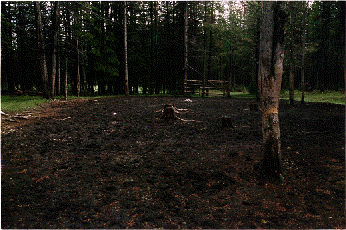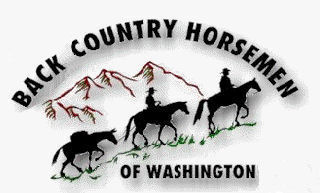Every trail has a history, and Back Country Horsemen of America defends our right to be a part of it from the back of a horse, the way our ancestors were. The Duckabush Trail tells a story of sustained hard work, needless calamity, and the progress that can be accomplished when people from different walks of life work together toward a specific goal. Back Country Horsemen of America is pleased to play a major part in this tale, from start to finish.
Annual Improvement
The Duckabush Trail starts in Olympic National Forest, about a 20-mile drive from Quilcene, Washington. It follows a remote stretch of the Duckabush River, crossing the Brothers Wilderness, then entering Olympic National Park from the east. The trail is easy except for the section that traverses Big Hump, where the grade is steep with a loose rock tread. Travelers must negotiate tight switchbacks threaded along high cliffs and deep drop-offs.
Every year, as Back Country Horsemen of Washington Peninsula Chapter assisted the Washington Trails Association with spring maintenance, the two groups frequently found ways to make stock travel safer along this trail. Areas around dangerous rocks were grubbed back to open more surface to walk on, trees were removed to make safer access to cliff-side trails, and dangerous water crossings were altered to reduce risk. In accordance with nationwide Wilderness regulations, no motorized vehicles or equipment was used; pack horses and mules hauled in the necessary gear and workers used hand tools instead of power tools.
 Up In Flames
Up In Flames
In September 2011, that hard work was nearly ruined by a careless visitor who failed to fully extinguish a campfire. At first, the flames only reached a few acres, but warm days of low humidity allowed them to flair and spread. The deep buildup of dry needles, leaves, and brush that naturally collects on the forest floor provided ample fuel. The wildfire burned the majestic Douglas fir, hemlock, and red cedar second-growth and old-growth trees that contribute to the stunning beauty of the Brothers Wilderness.
Within days, the fire was visible from Seattle, about 35 miles away. As many as 165 firefighting personnel battled the fire and helicopters drew water from area lakes and rivers to drop on the blaze. The steep, inaccessible terrain prevented firefighters from entering the Big Hump area, hindering their efforts on the ground. Finally, cooler daytime temperatures and a steady light rain contained and eventually smothered the fire, but not before it had incinerated 1,250 acres of protected land.
Walking on the Moon
One Back Country Horsemen of Washington member likened the landscape to stepping onto the moon. Charred trees littered the ground like pick-up-sticks, while others still stood precariously. Ashes and soot blanketed the forest floor. Organic material on the ground acts as mortar, holding rocks and gravel in place, but once it burned, gaps and crevasses opened up, making the already rugged area even more perilous. That vegetation also retains rainwater, releasing it slowly into the forest. Without it, water erodes the soil, creating holes and gullies.
 Dirty Work
Dirty Work
Although the difficulty of the terrain and the immensity of the project might have caused others to abandon the trail, the Peninsula Chapter of Back Country Horsemen of Washington attacked it with determination. They were there from the start of the restoration project, hauling in tools and supplies on their pack horses and mules for the US Forest Service Fire Crew to cut open the trail and remove the hazardous downed trees. The same hard working BCHW members and their pack stock then supported the Washington Trail Association workers who continued clearing the downfall and repaired the trail tread damage.
After nearly a year of effort, Duckabush Trail was re-opened in July 2012. Despite the long days, rough terrain, and challenge of soot and charcoal irritating noses and eyes, the trail has not only been restored, it has been even further improved. Some tight switchbacks required a horse to stop with its head over a precipice, then sidestep to negotiate the hairpin turn. These have been widened, allowing more natural and safe travel for saddle and pack stock.
An Avoidable Disaster
The Big Hump Fire is just one example proving the value of Leave No Trace Outdoor Ethics, which clearly state that campfires must be put out completely. Back Country Horsemen of America enthusiastically follows LNT principles and takes a leading role in educating others about the importance of responsible recreation. Government agencies and volunteer organizations oversee the care of our public lands, but protecting them is our job as individuals. Back Country Horsemen of America encourages horsemen and women to step out to the forefront in spreading the word about responsible recreation.
About Back Country Horsemen of America
BCHA is a non-profit corporation made up of state organizations, affiliates, and at-large members. Their efforts have brought about positive changes regarding the use of horses and stock in wilderness and public lands.
If you want to know more about Back Country Horsemen of America or become a member, visit their website: www.backcountryhorse.com; call 888-893-5161; or write PO Box 1367, Graham, WA 98338-1367. The future of horse use on public lands is in our hands!


Leave a Reply